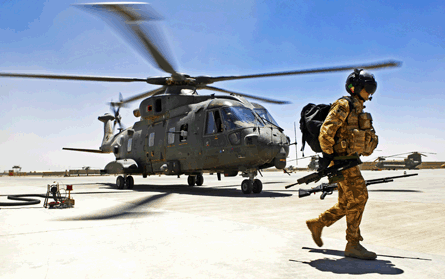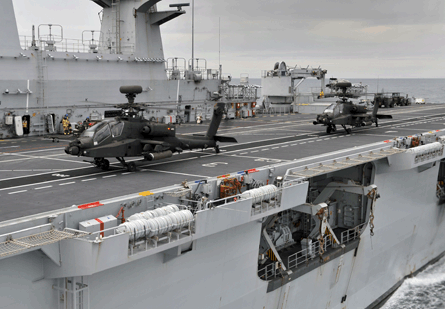Despite this being a time of intense budget pressure, one of the UK armed forces' main equipment areas has escaped with next to no spending cuts, due to the vital role that military rotorcraft play in current operations.
While swingeing reductions have eliminated seemingly essential assets, like the BAE Systems Harrier GR9 ground-attack aircraft and Nimrod MRA4 maritime patrol aircraft, plans to buy additional Boeing CH-47 Chinooks and upgrade Eurocopter Puma transport helicopters both survived the Strategic Defence and Security Review (SDSR). Long-standing commitments in Afghanistan - and also more recently over Libya - have resulted in the SDSR leaving the rotorcraft communities of the Army Air Corps (AAC), Royal Air Force and Royal Navy largely unscathed.
This has been welcome news for the tri-service Joint Helicopter Command (JHC) organisation, which is tasked with overseeing the operational activities of their multiple aircraft types.
 |
|---|
© Crown CopyrightThe UK sustains a detachment of 30-35 helicopters in Afghanistan, including RAF Merlin transports |
The UK's main focus for several years has been on Afghanistan, where it now has between 30 and 35 helicopters deployed in support of the NATO-led International Security Assistance Force.
Assigned to the UK's Joint Helicopter Force Afghanistan, or JHF(A), these span at least five types: the AgustaWestland AW101 Merlin HC3 and upgraded Lynx AH9A, Chinook HC2, Westland Sea King and Westland/Boeing Apache AH1 attack helicopter.
Their number also includes several aircraft being flown in support of UK special forces personnel, although the JHC declines to provide further public details of this capability.
The UK's helicopter operations are fully coordinated with the US Marine Corps' 2 Marine Aircraft Wing, at the combined Camp Bastion/Camp Leatherneck site in Helmand province, with their activities managed using the latter's air combat element structure.
The partners' contributions total around 3,900 and 580 personnel, respectively.
While the USMC also has a much larger air component of roughly 110 aircraft, ranging from the Bell AH-1W Cobra attack helicopter to the Bell Boeing MV-22 Osprey tiltrotor, Boeing AV-8B Harrier II and unmanned air vehicles, JHC officials say the UK offers key capabilities to the combined Task Force Jaguar. "When we go out on operations in central Helmand, it is frequently with [RAF] Chinooks being escorted by Cobras, and with our Apaches escorting [Sikorsky CH-53] Sea Stallions, and with any combination that you need to make a right fit for that particular mission," says British Army Col Neil Sexton, assistant director operations at the JHC. "We are fighting a joint fight. We are fully entwined, and it's a great way of doing business."
Sexton notes that despite the UK's smaller numerical contribution, "pro rata-wise, we fly a significantly greater number of hours per aircraft than they do. We don't have as many assets, but we work them harder."
Around one-third of the aircraft currently available to JHF(A) are Chinooks, with 11 providing the backbone of the UK's support helicopter presence. These are joined by RAF Merlin HC3s, Sea King HC4s from the navy's Commando Helicopter Force and recently upgraded army Lynx AH9As in delivering "lift" services. All the types are equipped with defensive aids system equipment and crew-served machine guns, in order for them to meet the UK's theatre-entry standard for use in the country.
 |
|---|
© Crown CopyrightShip-based Apaches are also currently involved in NATO's campaign over Libya |
Since arriving in Afghanistan after their withdrawal from Iraq, Merlins from the RAF's 28 and 78 squadrons transported over 750 tonnes of freight in their first year in Afghanistan, according to the JHC.
Their long-term use is yet to be fully determined, although current plans call for the service's HC3/3As to be transferred to the navy, to replace its Commando Helicopter Force's Sea King HC4s and support future amphibious and deployed operations.
Now equipped with LHTEC T800 engines - which will also power the UK's next-generation Lynx Wildcat aircraft - and flown in Afghanistan since early 2010, the AH9As also employ their L-3 Wescam MX-15 electro-optical/infrared sensors to support surveillance, or "find" requirements.
Apaches also use their targeting sensors and mast-mounted Hellfire fire control radar for this purpose, while the arrival of the navy's Sea King 7 airborne surveillance and control (ASaC) aircraft in May 2009 added a valuable and expanded capability.
Nicknamed "Baggers", the Searchwater radar-equipped Sea Kings had, by late July, completed 1,000 operational missions in Afghanistan, gathering "pattern of life" information with their synthetic aperture radar/ground moving target indication sensor.
They also are used to provide a near real-time wide-area surveillance capability in support of land forces, for example by tracking suspect vehicle movements, and have been instrumental in the recovery of more than 6,000kg (13,200lb) of explosives within the last few months, according to the Ministry of Defence.
The RN's 854 and 857 naval air squadrons have each supported one-year detachments in Afghanistan, with at least three of the helicopters currently in use.
In the "strike" category, the Lynx AH9A has been employed in some instances against ground threats, enabling Apache AH1s to be used elsewhere.
Involved in Afghanistan since 2007, the latter provide JHF(A) with its most potent offensive capability, carrying a 30mm cannon, unguided rockets and Lockheed Martin AGM-114 Hellfire air-to-surface missiles.
"The Hellfire missile has shown itself to be the weapon of choice for Apache attack helicopter operations, proving to be an accurate and reliable weapon system and providing airborne fire support to ground forces," says Peter Luff, UK minister for defence equipment, support and technology.
UK Apaches fired more than 550 Hellfires in combat and training exercises between January 2008 and May 2011, he revealed in response to a recent parliamentary question.
British Apaches are also currently involved in NATO's operation Unified Protector campaign, to protect Libyan civilians from attack by forces loyal to Col Muammar Gaddafi. The Hellfire has again proved a popular option since strikes commenced on 3 June. In one mission, conducted in early August, attack helicopters operating from the deck of HMS Ocean damaged or destroyed multiple regime targets around 64km (35nm) inland from Zuwarah.
"Hellfire missiles and cannon fire accounted for one headquarters and 12 military vehicles, including at least one armed with surface-to-air missiles, with another four vehicles left seriously damaged," the MoD said in a post-mission briefing.
 |
|---|
© Crown CopyrightRadar-equipped Sea Kings have impressed in current operations |
Apache missions in Libya are conducted using intelligence, surveillance and reconnaissance data collated by other assets, including Sea King ASaC aircraft also deployed aboard HMS Ocean, and RAF Raytheon Systems Sentinel R1 airborne standoff radar aircraft flown from Akrotiri, Cyprus.
Since the start of multinational operations against pro-Gaddafi forces on 19 March, UK assets have damaged or destroyed more than 850 regime targets.
Although decisions on the UK's continued equipment contribution to the Libyan operation - including whether to extend the availability of HMS Ocean and its deployed aircraft - are yet to be taken, meeting the demands of the Afghanistan mission remains JHC's top priority.
Reflecting this, roughly 440 of the command's personnel took part in a major pre-deployment exercise on Salisbury Plain, Wiltshire, in support of the British Army's 20 Armoured Brigade.
Split into three nine-day phases run from Netheravon airfield, the four-week exercise concluded on 21 August.
About 16 aircraft were flown each day, including the Apache, Chinook, Lynx, Merlin, Eurocopter Puma and Sea King.
AAC BN-2 Islander intelligence, surveillance and reconnaissance aircraft and Lockheed Desert Hawk III unmanned air vehicles also took part. JHC assets had logged roughly 1,500 flight hours in support of the activity by mid-August.
Based in Germany, 20 Armoured Brigade began training for its Afghan deployment around nine months ago.
"We put JHC officers into the brigade headquarters to train them up in the use of helicopters," says Sexton. "Not just getting into and out of the back, not just controlling Apache fires, but the intellectual process that goes to using aviation in a sensible way in Afghanistan."
Each exercise phase trained two battle groups of around 700 to 1,000 personnel, for example by inserting and extracting brigade reconnaissance teams using Chinooks.
Roughly 300 JHC staff who will also go to Afghanistan in the coming months also received training, while the readiness of its headquarters and joint operations centre personnel was validated.
As with a previous exercise conducted in January, the JHC's activities also included so-called "judgemental training", where the actions of air crew can be measured against recent real-life scenarios involving Taliban insurgents in Afghanistan.
"We give the crews an opportunity to relive the sort of scenarios that they'll face when they get deployed on operations. So if they are going to make a mistake they'll make it here," says exercise coordinator Lt Col Phil Cooke.
Although not part of the exercise scenario, 1 Regt AAC commanding officer Lt Col James Anderson, who will assume command of JHF(A) in late September, says growing emphasis is being placed on operating in conjunction with the Afghan military. This relationship will strengthen as the UK moves towards a planned withdrawal of its combat forces from the country in 2015, with control of its districts and provinces to progressively be transferred to local authorities. "We will be working more closely with the Afghan air force's [Mil] Mi-17s," Anderson says.
With the planned transfer of its Merlins to the Commando Helicopter Force, the RAF's support helicopter capability will eventually settle with its soon to-be expanded fleet of Chinooks and the upgraded Puma HC2.
The Chinook force will eventually total 46 glass cockpit-equipped HC4s and 14 new-build examples, with the type expected to remain in use until at least 2040.
At least 28 Pumas should be brought up to the improved HC2 standard, with Eurocopter having flown the first of these in late June. With more powerful Turbomeca Makila 1A1 engines, a digital flight control system and enhanced navigation and communications equipment, the type should reach full operating capability in 2014, and fly on until 2025.
"In the Strategic Defence and Security Review we set out our plans to deliver the helicopter capability to support 'Future Force 2020' through a mix of Apache, Chinook, Merlin, Lynx Wildcat and Puma helicopters," under-secretary of state for defence Lord Astor said, in response to a recent parliamentary question about potential UK military interest in Eurocopter's X3 high-speed demonstrator.
Source: Flight International



















